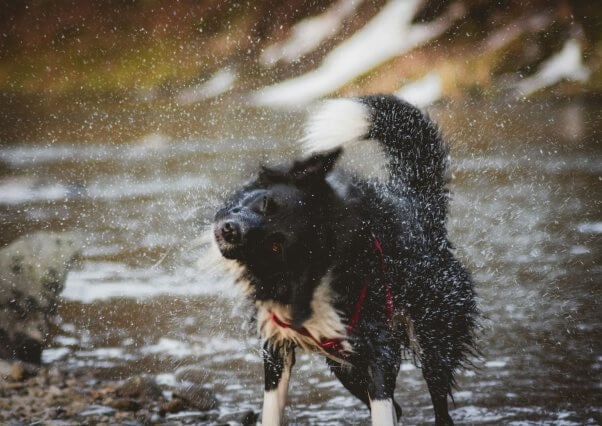Summertime can be fun for everyone—including our animal companions. Whether playing fetch in the backyard, enjoying a scenic “sniffari” (a walk on which your dog will be able to sniff whatever they want), or chilling in the air conditioning, their safety should always be a top priority. For water-loving canines, swimming in a pool or lake can be the highlight of summer and the ultimate way to beat the heat and burn off some excess energy. But beware. There’s a hidden risk that’s often overlooked: toxic blue-green algae in lakes and ponds. If your dog likes to swim, please read on.
What Is Blue-Green Algae?
Cyanobacteria (aka “blue-green algae”) are microscopic organisms with characteristics similar to algae and other plants. They typically thrive in lakes, ponds, reservoirs, or slow-moving streams but can also grow in buckets and other containers.

How to Identify Blue-Green Algae
There’s no way to know whether water is safe or toxic based on its appearance alone. Blue-green algae can look like foam, scum, mats, spilled green paint, or pea soup on the water’s surface. Remember: When in doubt, stay out!
What Causes Blue-Green Algae to Become Toxic?
Rising temperatures due to the human-caused climate catastrophe are behind warmer water conditions that accelerate the growth of cyanobacteria, leading to algal blooms. These blooms may produce toxins known as cyanotoxins, which can be dangerous or even fatal if ingested by humans or other animals. The risk is particularly high for dogs because they may drink contaminated water when swimming or lick their fur after exposure.
How to Protect Your Dog From Blue-Green Algae
Before swimming, check for local advisories and warnings about water quality, especially during warm months, when algal blooms are more common. If your destination appears to be safe, follow these recommendations before allowing your dog in the water:
- Avoid swimming in areas with visible algae, green water, or musty odors.
- Algal scum along shorelines has the highest concentrations of toxins, so don’t allow your dog to swim in or drink water from these areas.
- Rinse off your dog with fresh water after swimming in a lake.
- Keep them away from standing water.
- Watch for unusual symptoms after your dog has been in or around water. If you notice any signs of distress or illness, contact your veterinarian immediately.

Symptoms of Cyanotoxin Exposure in Dogs
Symptoms may include the following:
- Muscle rigidity
- Paralysis
- Seizures
- Excessive salivation
- Vomiting
- Diarrhea
- Pale or yellow gums
- Bleeding
What to Do if You Think Your Dog Has Been Exposed to Toxic Algae
Blue-green algae can cause symptoms in dogs—or even death—just 15 minutes to an hour after exposure. If you suspect that your dog may have been exposed to toxic algae, rinse their fur with fresh water and take them to a vet immediately. Every moment counts.
Other Essential Safety Tips for Dogs
Summer can be a wonderful time for dogs, filled with outdoor adventures and fun activities. By taking the following precautions and being aware of potential hazards, you can keep your dog safe and enjoy the season to the fullest:
- Never leave dogs in hot cars. Even with the windows cracked, it can take only minutes for a car to become dangerously hot, and dogs left inside can suffer from heatstroke or even die.
- Plan walks wisely. Hot pavement can burn a dog’s paws. Walk your dog early in the morning or late in the evening when the weather is cooler.
- Hydration is key. Make sure your dog always has access to fresh, cool water. This is especially important on hot days or after exercise.








